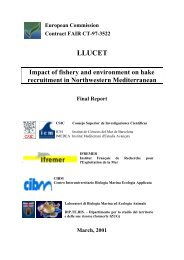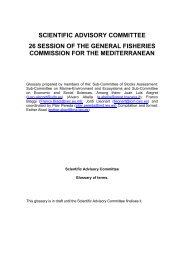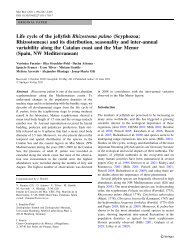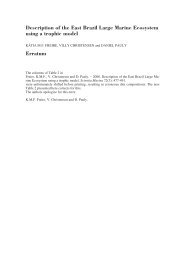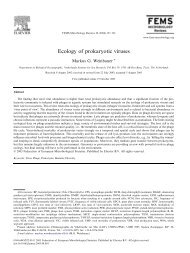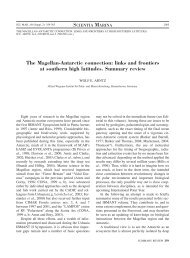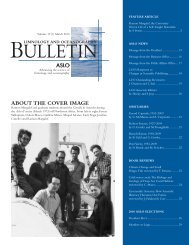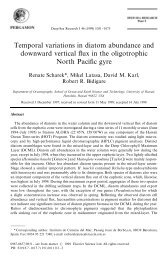REPORT OF THE WORKSHOP ON TRAWL SURVEY ... - FAO.org
REPORT OF THE WORKSHOP ON TRAWL SURVEY ... - FAO.org
REPORT OF THE WORKSHOP ON TRAWL SURVEY ... - FAO.org
Create successful ePaper yourself
Turn your PDF publications into a flip-book with our unique Google optimized e-Paper software.
Papaconstantinou C.)<br />
Abstract: Abundance distribution maps by means of “natural neighbour” algorithm (Surfer 8) for six elasmobranch<br />
species from the Greek seas were developed using MEDITS surveys data from 1994-2005. Five of the species<br />
found more abundant in the S. Aegean Sea, while the most abundant species were Raja clavata, Scyliorhinus<br />
canicula and Squalus acanthias.<br />
• Usefulness of the spatial indices to define the distribution pattern of key life stages:<br />
an application on the red mullet population in the south Tyrrhenian sea (by Spedicato<br />
M.T., M. Woillez, J. Rivoirard, P. Petitgas, P. Carbonara, G. Lembo)<br />
Abstract: This study aims to explore the performance of the approach based on spatial indicators to characterise<br />
with quantitative metrics the spatial dynamics of red mullet life stages (recruits and adults), to identify areas where<br />
red mullet recruits are more concentrated, to establish relationships with the adult distribution and to detect the<br />
ability of spatial indicators to capture the stability of the spatial occupation of preferential areas across the years.<br />
Data are from the GRU.N.D. experimental trawl surveys. The methodological approach used in this study is based<br />
on the estimate of spatial indicators as developed within the EU Fisboat project. The results proved that many of the<br />
9 examined spatial indicators and pairwise relationships, between indicators and abundance, enabled us to better<br />
understand the spatial distribution and interannual variability of the red mullet population life stages and the<br />
relationships between spatial distribution and abundance. In addition, we identified the geographical area<br />
(southwards,- along the Calabria coast) where recruits of red mullet resulted mainly distributed and we also verified<br />
that these locations are stable across years.<br />
• Nursery areas of hake (Merluccius merluccius) and deep-water rose shrimp<br />
(Parapenaeus longirostris) in the Central Mediterranean Sea: perspectives for fishery<br />
management (by Carlucci R., D’Onghia G. Lembo G., Maiorano P., Marano C.A.,<br />
Sion L., Spedicato M.T., Ungaro N.<br />
Abstract: The spatial pattern of nursery areas of hake and deep-water rose shrimp was studied in Southern Adriatic<br />
and Northern Ionian Sea (Central Mediterranean) using geostatistical tools and data from trawl surveys time series<br />
conducted in the area. The analysed variables were: R (number of recruits/km2) and R/Tot (fraction of recruits on<br />
the total sampled population). The structural analysis showed a spatial pattern of both variables characterized by<br />
continuity at a small scale level. Predictions of nursery areas localization with probability of finding recruits at<br />
different threshold values were obtained through median indicator kriging. The main concentration of hake<br />
juveniles were estimated within 100-200 m depth along the Gargano peninsula and in the Otranto Channel, where<br />
the nursery of deep-water rose shrimp was mainly localised. A depth overlapping, between 100 and 200 m, was<br />
identified for hake and deep-water rose shrimp nurseries. Protection of these areas through limitations of fishing<br />
pressure is discussed.<br />
The use of trawl survey data in the ICES region for assessment<br />
12. One presentation was given under this topic. The whole document is reported in<br />
Appendix 4, while the abstract is given below.<br />
• The use of trawl survey data in the ICES region for assessment purposes (by M.<br />
Armstrong)<br />
Abstract: This presentation gives an overview of the use of trawl surveys in stock assessments carried out by the<br />
ICES scientific community. Aspects of survey design and survey standardisation/inter-vessel calibration are<br />
covered. The primary use for the surveys is to provide time-series data on abundance and distribution by size or<br />
age, and the main use is in the “tuning” of different types of sequential population analysis (SPA). Survey-only<br />
models are also widely used for providing fishery-independent trends in stock abundance, and for investigating the<br />
quality of the survey data. North Sea haddock is given as an example of both approaches. An important issue for<br />
many catch-based assessments is dealing with bias due to apparent trends in survey catchability. The trends may be<br />
due to problems with the fishery data, or to actual changes in catchability. Some assessments of European cod<br />
stocks use survey data to estimate unaccounted-for removals, for example due to misreported or discarded catch.<br />
Surveys are also widely used for providing data on biological parameters of stocks, and increasingly for providing<br />
information in support of ecosystem approaches to fishery management.<br />
7




